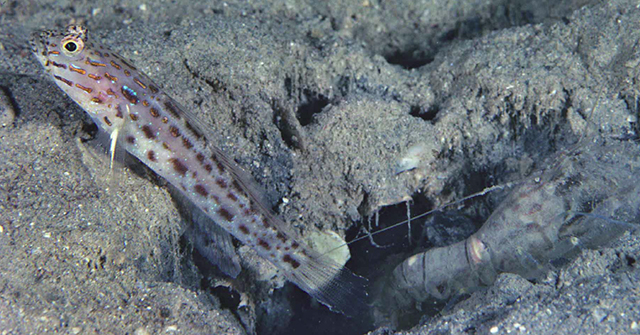| Gobiidae (Gobies), subfamily: Gobiinae |
| 5.49 cm SL (male/unsexed) |
|
reef-associated; marine; depth range 1 - 15 m |
| Indo-Pacific: widespread, from the Red Sea to the western Pacific, with records from the Great Barrier Reef and the Ryukyu Islands. |
|
Dorsal spines (total): 7-7; Dorsal soft rays (total): 11-12; Anal spines: 1-1; Anal soft rays: 11-11. This species is distinguished by the following characters: D VI + I,11-12; A I,11; pectoral rays 19; longitudinal scale series 55-60; body depth 4.8-5.2 in SL; head length (HL) 3.1-3.3 in SL; dorsal profile of snout forming an angle of about 40° to horizontal axis of head and body; wide gill opening, reaching forward nearly to a vertical at posterior edge of eye; 2nd dorsal spine equal to or slightly longer than first spine and longer than the third spine, and about equal to the body depth (0.9-1.1); rounded caudal fin, 1.1-1.3 in HL; body with 4 longitudinal rows of dark brown spots, the 1st and 3rd as thick dashes, the spots of second row much smaller, except large first one over upper end of gill opening; 4th row ventrally on body with 2 or 3 spots on abdomen approaching pupil size, remaining spots only dark flecks; postorbital head with 3 oblique rows of dark dashes at an angle less than 45°, the 1st a single long dash behind eye, the next 2 across cheek, ending on upper half of opercle; 4 oblique rows of dark brown dashes and dots from eye across lips; median, dark brown, V-shaped mark dorsally on snout absent; in life, no small yellow flecks ventrally on body; larger dark spots on ventral half of body often encircled with blue dots; pectoral fins with a small white dash at upper base, a long white streak from base, narrowing into middle of fin (Ref. 90180). |
|
|
Least Concern (LC); Date assessed: 13 March 2015 Ref. (130435)
|
| harmless |
|
Collected from the Andaman Sea coast of Thailand, from protected bays in sand or sandy mud bottoms, with coral rubble, in symbiotic association with alpheid shrimps (Ref. 92906). |
Source and more info: www.fishbase.org. For personal, classroom, and other internal use only. Not for publication.

